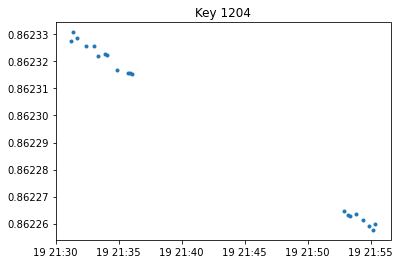In my previous post I presented a description of the X-band telemetry of Lucy, including a GNU Radio decoder, some recordings from the Allen Telecope Array, and an analysis of some of the telemetry received in the two days following the launch. This is a short post with some updates about the telemetry analysis of the Lucy mission.
As described earlier, immediately after launch Lucy was using 60 kbaud (~10 kbps) PCM/PSK/PM with a subcarrier of 281.25 kHz, using r=1/6 Turbo coding. At some point before 2021-10-19 19:55 UTC, it changed its modulation to 120 kbaud (~20 kbps), maintaining the rest of the parameters. A couple days later, before 2021-10-21 20:41 UTC, it changed the modulation again to PCM/PM/NRZ, that is, baseband residual-carrier phase modulation. A baudrate of 300 kbaud was used to achieve a net rate of ~50 kbps. The Turbo code parameters stayed unchanged. The spacecraft has remained in this mode since then.
Since my last post, I have analyzed the following recordings. On 2021-10-19, Iban Cardona EB3FRN made some recordings with his 2.4 metre dish. Lucy was already using 120 kbaud, and the SNR was borderline to decode. I tried to optimize the decoder, and made this flowgraph. Only around 35% of the frames could be decoded successfully. In one of the recordings the decodes stopped after a few minutes, even though an SNR drop wasn’t noticeable. Still, the decodes were enough to take a look at the telemetry (see the Jupyter notebook).
Comparing this data with the one I obtained with ATA on 2021-10-17, it was apparent that some telemetry values that on 2021-10-17 seemed completely stationary, on 2021-10-19 had started to change with time. In particular, among keys 1202-1210 from APID 5, the only one which changed with time on 2021-10-17 was 1206, which showed a very clear linear slope. However, on 2021-10-17 all of these keys except 1208-1210 showed a linear slope.
As an example, this figure shows key 1204 on the UTC morning of 2021-10-17. We see that the average value is 0.462, and the value only oscillates 2e-6 about the average.

However, on the UTC evening of 2021-10-19 the behaviour changed, and we can see the value of key 1204 change linearly with time. The gap between 21:35 and 21:50 corresponds to the gap between the two recordings that Iban made.

Still I have no clue of what these telemetry values are, but the fact that we can notice a change in their behaviour comparing the data from 2021-10-17 and 2021-10-19 is interesting.
The APIDs in use on 2021-10-19 and their distribution seems to be more or less the same as in 2021-10-17, and other characteristics such as the number of virtual channels haven’t changed either.
Iban also made some recordings on the UTC evening of 2021-10-20 UTC. Only very few frames could be decoded from these recordings, but this is in fact amazing, since the increase in free space path loss placed the SNR below decoding threshold. The telemetry is analysed here. It is very similar to that recorded on 2021-10-19. After this day, given the change to 300 kbaud and the further increase in path loss, it would be completely impossible for Iban’s 2.4 metre dish to decode anything.
On the UTC morning of 2021-10-23 I made a long recording with ATA using two 6.1 metre antennas. Using the RHCP data from only one of the antennas, the SNR is not good enough, and only a few frames can be decoded. I hope that with the 3dB SNR increase that comes from arraying the two antennas I’ll be able to decode most of the frames. However, I haven’t done this yet, since I need to prepare something to correct for the delay difference between the antennas, and to adapt my auto-polarization block to work with 4 channels instead of 2 (so that it does phase-only beamforming by using the residual carrier as a phase reference).
Peter Gülzow DB2OS, from AMSAT-DL, used the 20 metre antenna at Bochum observatory to record some IQ data on 2021-10-24. I decoded the 300 kbaud signal with this flowgraph and obtained the frames that are analysed here. The recording lasts 4 minutes, and almost all of the frames could be decoded correctly, since the SNR was good.
The behaviour of the telemetry seems very similar to that decoded from Iban’s recording. I would say that there hasn’t been any major change in the telemetry since the change to the high-gain antenna and the change to 120 kbaud. It is noteworthy that the rate at which real-time telemetry is sent is still quite low, so with a 50 kbps signal most of the frames are idle.
As always, all the data, flowgraphs and telemetry analysis I have for Lucy can be found in this folder.